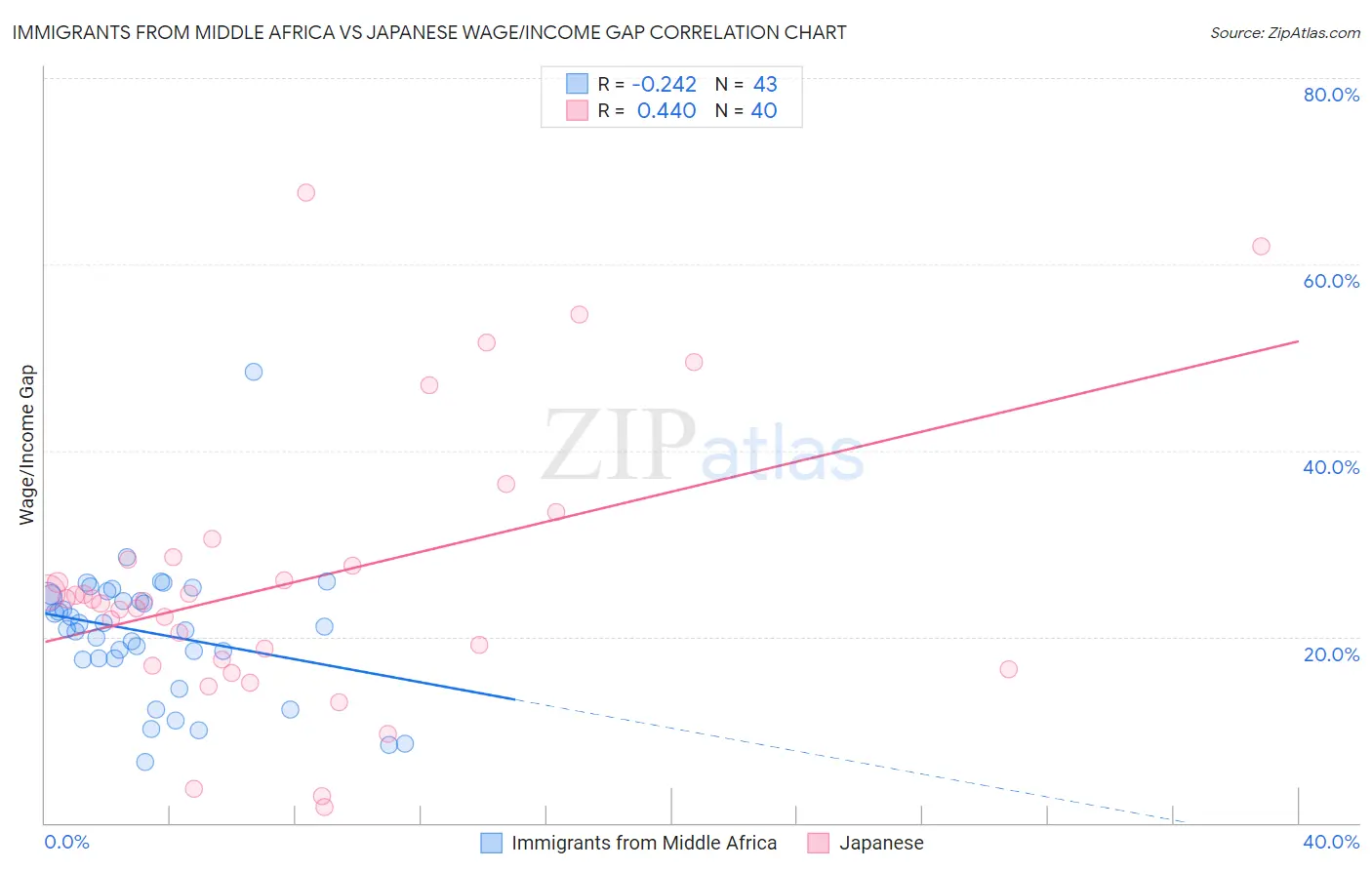Immigrants from Middle Africa vs Japanese Wage/Income Gap
COMPARE
Immigrants from Middle Africa
Japanese
Wage/Income Gap
Wage/Income Gap Comparison
Immigrants from Middle Africa
Japanese
22.4%
WAGE/INCOME GAP
100.0/ 100
METRIC RATING
60th/ 347
METRIC RANK
23.8%
WAGE/INCOME GAP
99.1/ 100
METRIC RATING
101st/ 347
METRIC RANK
Immigrants from Middle Africa vs Japanese Wage/Income Gap Correlation Chart
The statistical analysis conducted on geographies consisting of 202,693,436 people shows a weak negative correlation between the proportion of Immigrants from Middle Africa and wage/income gap percentage in the United States with a correlation coefficient (R) of -0.242 and weighted average of 22.4%. Similarly, the statistical analysis conducted on geographies consisting of 249,130,971 people shows a moderate positive correlation between the proportion of Japanese and wage/income gap percentage in the United States with a correlation coefficient (R) of 0.440 and weighted average of 23.8%, a difference of 6.4%.

Wage/Income Gap Correlation Summary
| Measurement | Immigrants from Middle Africa | Japanese |
| Minimum | 6.5% | 1.7% |
| Maximum | 48.4% | 67.8% |
| Range | 41.9% | 66.0% |
| Mean | 20.4% | 26.0% |
| Median | 21.1% | 23.9% |
| Interquartile 25% (IQ1) | 17.7% | 17.2% |
| Interquartile 75% (IQ3) | 24.5% | 28.4% |
| Interquartile Range (IQR) | 6.9% | 11.2% |
| Standard Deviation (Sample) | 7.1% | 14.8% |
| Standard Deviation (Population) | 7.1% | 14.6% |
Similar Demographics by Wage/Income Gap
Demographics Similar to Immigrants from Middle Africa by Wage/Income Gap
In terms of wage/income gap, the demographic groups most similar to Immigrants from Middle Africa are Navajo (22.4%, a difference of 0.020%), Immigrants from Cuba (22.4%, a difference of 0.060%), Ghanaian (22.3%, a difference of 0.14%), Immigrants from Fiji (22.4%, a difference of 0.17%), and Immigrants from Ghana (22.3%, a difference of 0.24%).
| Demographics | Rating | Rank | Wage/Income Gap |
| Bangladeshis | 100.0 /100 | #53 | Exceptional 22.2% |
| Nepalese | 100.0 /100 | #54 | Exceptional 22.2% |
| Immigrants | Zaire | 100.0 /100 | #55 | Exceptional 22.3% |
| Immigrants | Ghana | 100.0 /100 | #56 | Exceptional 22.3% |
| Ghanaians | 100.0 /100 | #57 | Exceptional 22.3% |
| Immigrants | Cuba | 100.0 /100 | #58 | Exceptional 22.4% |
| Navajo | 100.0 /100 | #59 | Exceptional 22.4% |
| Immigrants | Middle Africa | 100.0 /100 | #60 | Exceptional 22.4% |
| Immigrants | Fiji | 100.0 /100 | #61 | Exceptional 22.4% |
| Immigrants | Guatemala | 100.0 /100 | #62 | Exceptional 22.5% |
| Immigrants | Ecuador | 100.0 /100 | #63 | Exceptional 22.5% |
| Spanish American Indians | 100.0 /100 | #64 | Exceptional 22.5% |
| Guatemalans | 99.9 /100 | #65 | Exceptional 22.6% |
| Central American Indians | 99.9 /100 | #66 | Exceptional 22.7% |
| Menominee | 99.9 /100 | #67 | Exceptional 22.7% |
Demographics Similar to Japanese by Wage/Income Gap
In terms of wage/income gap, the demographic groups most similar to Japanese are Immigrants from Laos (23.8%, a difference of 0.14%), Yakama (23.7%, a difference of 0.15%), Aleut (23.7%, a difference of 0.17%), Immigrants from Latin America (23.7%, a difference of 0.25%), and Tsimshian (23.9%, a difference of 0.37%).
| Demographics | Rating | Rank | Wage/Income Gap |
| Hondurans | 99.5 /100 | #94 | Exceptional 23.6% |
| Cape Verdeans | 99.4 /100 | #95 | Exceptional 23.6% |
| Kiowa | 99.4 /100 | #96 | Exceptional 23.6% |
| Immigrants | Sudan | 99.4 /100 | #97 | Exceptional 23.6% |
| Immigrants | Latin America | 99.2 /100 | #98 | Exceptional 23.7% |
| Aleuts | 99.2 /100 | #99 | Exceptional 23.7% |
| Yakama | 99.2 /100 | #100 | Exceptional 23.7% |
| Japanese | 99.1 /100 | #101 | Exceptional 23.8% |
| Immigrants | Laos | 99.0 /100 | #102 | Exceptional 23.8% |
| Tsimshian | 98.9 /100 | #103 | Exceptional 23.9% |
| Tlingit-Haida | 98.7 /100 | #104 | Exceptional 24.0% |
| Moroccans | 98.6 /100 | #105 | Exceptional 24.0% |
| Sudanese | 98.6 /100 | #106 | Exceptional 24.0% |
| Yaqui | 98.4 /100 | #107 | Exceptional 24.0% |
| Immigrants | Albania | 98.4 /100 | #108 | Exceptional 24.0% |